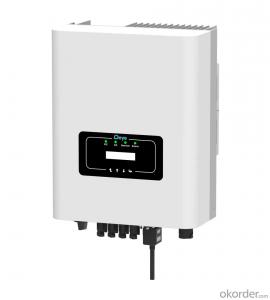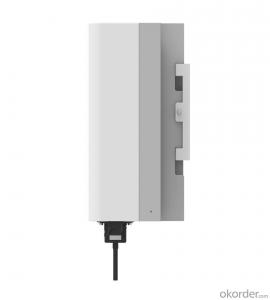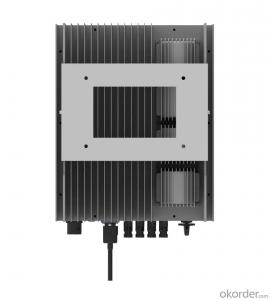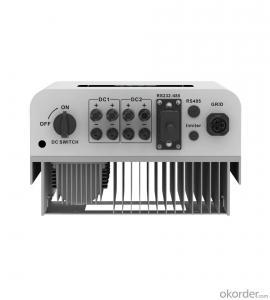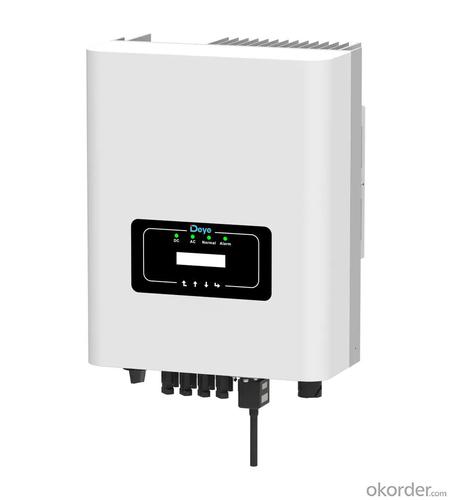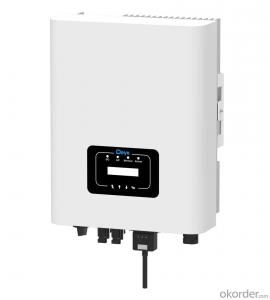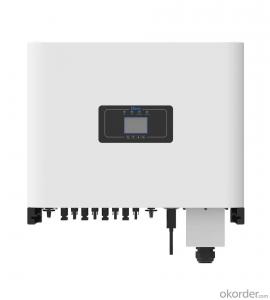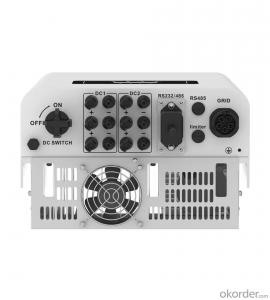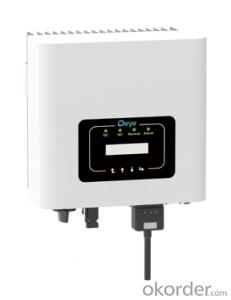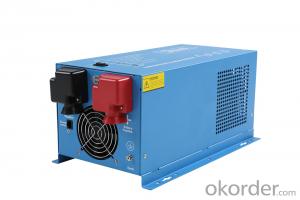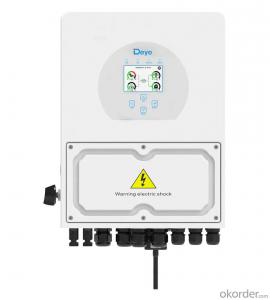200KW Solar Inverter - Sun-7/7.5/8/9/10/10.5k-g | 7-10.5kW | Single Phase | 2 MPPT
- Loading Port:
- Ningbo
- Payment Terms:
- TT OR LC
- Min Order Qty:
- 100 pc
- Supply Capability:
- 5000 pc/month
OKorder Service Pledge
OKorder Financial Service
You Might Also Like
Specification
| Model | SUN-7K-G | SUN-7.5K-G | SUN-8K-G | SUN-9K-G | SUN-10K-G | SUN-10.5K-G | |
| Input Side | |||||||
| Max. DC Input Power (kW) | 9.1 | 9.8 | 10.4 | 11.7 | 13 | 13.7 | |
| Max. DC Input Voltage (V) | 550 | ||||||
| Start-up DC Input Voltage (V) | 80 | ||||||
| MPPT Operating Range (V) | 70~500 | ||||||
| Max. DC Input Current (A) | 13+26 | 26+26 | |||||
| Max. Short Circuit Current (A) | 19.5+39 | 39+39 | |||||
| Number of MPPT / Strings per MPPT | 2/1+2 | 2/2 | |||||
| Output Side | |||||||
| Rated Output Power (kW) | 7 | 7.5 | 8 | 9 | 10 | 10.5 | |
| Max. Active Power (kW) | 7.7 | 8.25 | 8.8 | 9.9 | 11 | 11.55 | |
| Nominal Output Voltage / Range (V) | L/N/PE 220V/0.85Un-1.1Un, 230V/0.85Un-1.1Un (Optional) | ||||||
| Rated Grid Frequency (Hz) | 50 / 60 (Optional) | ||||||
| Operating Phase | Single phase | ||||||
| Rated AC Grid Output Current (A) | 30.4 | 32.6 | 34.8 | 39.1 | 43.5 | 45.7 | |
| Max. AC Output Current (A) | 33.5 | 35.9 | 38.3 | 43 | 47.8 | 50.2 | |
| Output Power Factor | 0.8 leading to 0.8 lagging | ||||||
| Grid Current THD | <3% | ||||||
| DC Injection Current (mA) | <0.5% | ||||||
| Grid Frequency Range | 47~52 or 57~62 (Optional) | ||||||
| Efficiency | |||||||
| Max. Efficiency | 97.7% | ||||||
| Euro Efficiency | 97.5% | ||||||
| MPPT Efficiency | >99% | ||||||
| Protection | |||||||
| DC Reverse-Polarity Protection | Yes | ||||||
| AC Short Circuit Protection | Yes | ||||||
| AC Output Overcurrent Protection | Yes | ||||||
| Output Overvoltage Protection | Yes | ||||||
| Insulation Resistance Protection | Yes | ||||||
| Ground Fault Monitoring | Yes | ||||||
| Anti-islanding Protection | Yes | ||||||
| Temperature Protection | Yes | ||||||
| Integrated DC Switch | Yes | ||||||
| Remote software upload | Yes | ||||||
| Remote change of operating parameters | Yes | ||||||
| Surge protection | DC Type II / AC Type II | ||||||
| General Data | |||||||
| Size (mm) | 330W×410H×198.5D | ||||||
| Weight (kg) | 15.7 | ||||||
| Topology | Transformerless | ||||||
| Internal Consumption | <1W (Night) | ||||||
| Running Temperature | -25~65℃, >45℃ derating | ||||||
| Ingress Protection | IP65 | ||||||
| Noise Emission (Typical) | <25 dB | ||||||
| Cooling Concept | Natural cooling | ||||||
| Max. Operating Altitude Without Derating | 2000m | ||||||
| Warranty | 5 years | ||||||
| Grid Connection Standard | CEI 0-21, VDE-AR-N 4105, NRS 097, IEC 62116, IEC 61727, G99, G98, VDE 0126-1-1, RD 1699, C10-11 | ||||||
| Operating Surroundings Humidity | 0-100% | ||||||
| Safety EMC / Standard | IEC/EN 61000-6-1/2/3/4, IEC/EN 62109-1, IEC/EN 62109-2 | ||||||
| Features | |||||||
| DC Connection | MC-4 mateable | ||||||
| AC Connection | IP65 rated plug | ||||||
| Display | LCD1602 | ||||||
| Interface | RS485/RS232/Wifi/LAN | ||||||
· 2 MPP trackers, Max. efficiency up to 97.7%
· Zero export application, VSG application
· String intelligent monitoring (optional)
· Wide output voltage range
· Anti-PID function (Optional)
The single-phase inverter is one of the best options for residential application thanks to its smaller size and local LCD display, buttons. Also, with built-in zero-export function (external CT is needed), it offers true ease and comfort for PV system operators and installers.
- Q: How does a solar inverter handle voltage and frequency variations caused by switching operations?
- Through its built-in control mechanisms and advanced technology, a solar inverter is specifically designed to handle voltage and frequency variations resulting from switching operations. When connected to the grid, the solar inverter actively monitors the grid's voltage and frequency, and adjusts its operation accordingly to ensure stability and safety. When voltage variations occur due to switching operations, a solar inverter typically employs a voltage control mechanism. This mechanism continuously monitors the grid's voltage level, and accordingly adjusts the inverter's output voltage to match the grid voltage. If the grid voltage exceeds or falls below a specific threshold, the inverter automatically compensates by adjusting its output voltage to maintain a stable level. Similarly, for frequency variations caused by switching operations, a solar inverter utilizes a frequency control mechanism. This mechanism constantly monitors the grid's frequency and adjusts the inverter's output frequency to match the grid's frequency. If the grid's frequency deviates from the standard, the inverter promptly responds by adjusting its output frequency to ensure synchronization with the grid. To achieve precise control, solar inverters often integrate advanced digital signal processing algorithms and sophisticated control systems. These algorithms and control systems analyze the voltage and frequency signals from the grid, and based on predefined parameters, swiftly make adjustments to the inverter's output. This ensures compatibility with the grid and promotes seamless integration. Ultimately, the primary objective of a solar inverter is to seamlessly integrate with the grid, providing a stable, reliable, and efficient power supply. By effectively managing voltage and frequency variations resulting from switching operations, the inverter plays a crucial role in maintaining the overall stability and resilience of the grid. This allows for optimal utilization of solar energy and contributes to a sustainable energy future.
- Q: What is the role of a solar inverter in preventing system downtime?
- The role of a solar inverter in preventing system downtime is to convert the direct current (DC) produced by solar panels into alternating current (AC) that can be used to power electrical devices and to feed excess energy back into the grid. By maintaining a stable and reliable flow of electricity, solar inverters help prevent disruptions and downtime in the solar energy system, ensuring continuous operation and maximizing energy efficiency.
- Q: How is the efficiency of a solar inverter measured?
- The efficiency of a solar inverter is typically measured by calculating the ratio of the output power to the input power. This is done by dividing the AC power output by the DC power input, and then multiplying the result by 100 to obtain a percentage value.
- Q: What are the safety considerations when installing a solar inverter?
- Some safety considerations when installing a solar inverter include ensuring proper grounding and electrical connections, following manufacturer's guidelines and instructions, and having a licensed electrician perform the installation. It is also important to be cautious of potential electrical hazards and to handle the inverter with care to avoid any personal injuries.
- Q: How does a solar inverter handle frequency variations in the grid?
- A solar inverter handles frequency variations in the grid by continuously monitoring the frequency and adjusting its own output accordingly. If the grid frequency increases, the inverter reduces its output to prevent overloading. Conversely, if the frequency decreases, the inverter increases its output to maintain a stable supply. This dynamic response ensures that the solar inverter efficiently synchronizes with the grid and contributes to grid stability.
- Q: Can a solar inverter be used in three-phase systems?
- Yes, a solar inverter can be used in three-phase systems. In fact, three-phase solar inverters are commonly used in commercial and industrial applications where a three-phase power supply is available. These inverters are designed to convert the DC power generated by solar panels into AC power suitable for use in three-phase systems.
- Q: How does a solar inverter handle reactive power compensation?
- A solar inverter handles reactive power compensation by utilizing reactive power control techniques. It can dynamically regulate the amount of reactive power injected into or absorbed from the electrical grid. This helps maintain the power factor at the desired level, improving system efficiency and reducing grid instability caused by reactive power fluctuations.
- Q: How do you calculate the power loss in a solar inverter?
- To calculate the power loss in a solar inverter, you would subtract the output power of the inverter from its input power. The input power can be determined by measuring the DC current and voltage at the input, while the output power can be determined by measuring the AC current and voltage at the output. The difference between the input and output power represents the power loss in the solar inverter.
- Q: Can a solar inverter be installed indoors?
- Yes, a solar inverter can be installed indoors.
- Q: Can a solar inverter be used with a single solar panel?
- Yes, a solar inverter can be used with a single solar panel. The purpose of a solar inverter is to convert the direct current (DC) generated by the solar panel into usable alternating current (AC) electricity. Whether you have one or multiple solar panels, a solar inverter is necessary to convert the DC power into AC power that can be used to power electrical appliances or be fed back into the grid.
Send your message to us
200KW Solar Inverter - Sun-7/7.5/8/9/10/10.5k-g | 7-10.5kW | Single Phase | 2 MPPT
- Loading Port:
- Ningbo
- Payment Terms:
- TT OR LC
- Min Order Qty:
- 100 pc
- Supply Capability:
- 5000 pc/month
OKorder Service Pledge
OKorder Financial Service
Similar products
Hot products
Hot Searches
Related keywords
